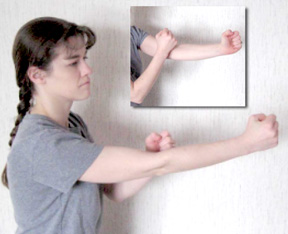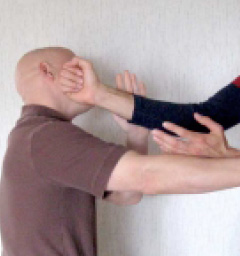Straight Blast Lesson
How fast, powerful, and efficient is your straight blast?
Can you fire off a series of very short, fast punches, where each fist starts from elbow distance of the other extended arm? Can you unleash a barrage of punches with even less distance between each punch?
If you make a few modifications (improvements) to your straight-blast series, then you can significantly increase the effectiveness of the flurry of hits. Can you guess which improvements, I’ll suggest?
A JKD-Wing-Chun Story
Before we get into the specifics of these modifications, I’d like to tell you about something that recently happened to me … and relates to making martial-arts improvements:
I was up north at my martial-arts teacher’s class. We were moving and punching, combining weapon-first actions with our footwork. At one point, still leading with the punch, I moved in what I’d describe as a very traditionally wing-chun type of scoot.
My teacher, Steve Golden, frowned.
I didn’t think he was frowning at the wing-chun feeling of the move. After all, a good move is a good move, no matter what style. Besides, he favors much of what that gung fu style has to offer.
Later, in the evening, when he was correcting my interrupted timing (yet again), I told him that while I was having problems with this one type of footwork, I had other types of broken rhythm footwork down pat.
So, I proceeded to demonstrate….
And there was that exact frown, once again. Except this time, he said, “That’s not as smooth as you think; it could use a little improvement.”
Even though I have been doing that move for 30 years, Steve still saw a different level that I hadn’t yet reached.
Note: I can tell when he’s teasing, and when he’s serious. He wasn’t just yanking my chain on this one. He saw something that I didn’t.
 What’s The Connection to Straight Blast Punching?
What’s The Connection to Straight Blast Punching?
How does the above story relate to rapid-fire hits? Well, after a long time in the martial arts, although not nearly as long as Steve Golden, there are certain indicators of how accomplished someone is with his or her straight-blast hits.
Even though we go much more in depth in the Punch eCourse in our perfection of the straight blast, here are a couple of “tells” that let me know the person in front of me still has a ways to go (more learning) or if he or she has mastered many of the finer details:
Circular Punching
We call them “straight” blasts for a reason. They are supposed to be straight — direct and efficient. Circular blasting is less efficient; it takes more time. And the hit isn’t quite as solid either (although you can correct for this).
In The Punch eCourse, I refer to this punch problem as “bicycle pedaling.”
Punching Over Or Under?
Another tell that the martial artist in front of you is a beginner is if his or her other arm gets in the way of the fist punching.
If you are punching on a straight line, and you are hitting in a fast series, then it makes sense the most of the time, the previously-extended arm is going to have to get out of the way for the fist now punching.
Agreed, right?
Well, a big, glaring boo boo is when the puncher tries to go over the arm, in order to punch low, or drops the fist under the extended arm, in order to punch upwards. These are mistakes, because:
- you have to change direction
- you aren’t punching on a straight line
- you are telegraphing your intent
 This often happens when someone tries to vary the height of the punches within the straight blast.
This often happens when someone tries to vary the height of the punches within the straight blast.
Which reminds me …
Beginning Punching Bonus
There’s another way to tell if someone is a beginner at straight blasts, although in a real fight, you might never get the opportunity to see if your opponent has practiced variations. In other words, the fight could be over in an instant.
One big indicator that the person in front of you is a beginning straight blaster is if he or she has the skill to punch at different heights, and mix and match, almost at random.
If you have someone who only knows to punch along one line, then you know that he or she hasn’t explored the real power (pardon the pun) of the straight blast.
Once beginners start to explore punching low-low-high-medium-high-low-low-high-medium-medium and so on, that’s when they begin to have problems of one fist running into the extended other arm.
Thoughts on these straight blast indicators?
Tags: improve punching, jeet kune do, jkd, punch faster, punch harder, punching, rapid punching, steve golden, straight blast punching, straight blasts, telegraphs, wing chun


